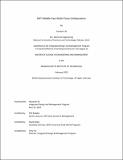| dc.description.abstract | The Middle East comprises much of the Arab world, including Egypt and Israel. It is the birthplace of three major world religions. The modern history of the region has been marked with a series of geopolitical upheavals that have fragmented the countries that make up this place. In August of 2020, however, there was an historic shift away from fragmentation when an agreement of diplomatic, economic, trade and cultural collaboration was signed between Israel and UAE. This was soon followed by a similar agreement between Israel and Bahrain which further sparked normalization agreements with Sudan, and then with Morocco. Combined, these series of agreements were known as the Abraham Accords. This is important for multiple reasons:
• This transition to normalization occurred after a long history of absence or lack of any diplomatic or trade relations despite being in the same region.
• The Abraham Accords have the potential open doors for the remaining countries in the region, among which Saudi Arabia is the largest and one of the richest in the world, to also normalize relations with Israel and thus pave way for a collaborative network innovation ecosystems for the region
• Viewed from the MIT lens of entrepreneurship and innovation, Israel stands out as the clear powerhouse in the region followed by a very distant second, UAE, which in recent years is doubling down on building and expanding its own entrepreneurial ecosystem.
The idea of a ‘Middle East Multi Partner Initiative’ was explored from within MIT International Science and Technology Initiatives (MISTI) while aiming to engage across the Institute. The initiative to build on recent geopolitical developments in the region to reach across borders to make regional impact is in its nascent stages of development. Its goal is to promote collaborative solutions to major challenges in the region that often share the same set of geographical, economic, and social hurdles, but lack bridges for knowledge sharing as well as symbiotic and sustainable partnerships.
My work explores the current state of the region from the lens of potential entrepreneurial and economic collaboration, the key areas to focus on, and the most effective framework for MIT to build bridges between multiple countries by leveraging MIT’s programs, researchers, students, and the alumni body who are either based in the region or involved in research or coursework in these countries. For the 200+ MIT students that in a typical year annually take part in professional experiences in the region, this initiative could bring together new and existing partners in multi-partner engagement while simultaneously offering transformative educational experiences for MIT students and meaningful research opportunities for MIT faculty in the region. | |
